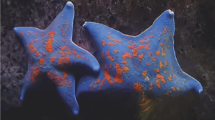Abstract
Using the method of nuclear magnetic-resonance spectroscopy, lactic acid, alanine, and aspartate were revealed in the coelomic fluid of the black sea urchin Mesocentrotus nudus, which indicates anaerobic metabolism in echinoderms. Energy metabolism of this type is intensified in stressful situations, when the inflow of oxygen into cells becomes insufficient. This compensatory response of energy metabolism is an important mechanism for adaptation to changing environmental conditions.
Similar content being viewed by others
References
Biokhimiya: Uchebnik dlya vuzov (Biochemistry: Manual for Higher Education Institutions), Severin, E.S., Ed., Moscow: Geotar-Media, 2003.
Drozdov, K.A., The use of magnetic resonance imaging and spectroscopy for characterizing the functional and metabolic changes in brain during the early post-concussion recovery period, Extended Abstract of Cand. (Biol.) Sci. Dissertation, St. Petersburg, 2013.
Kolokolova, T.N., Savel’ev, O.Yu., and Sergeev, N.M., Metabolic analysis of human biological fluids by 1H NMR spectroscopy, J. Anal. Chem., 2008, vol. 63, no. 2, pp. 104–120.
Laborit, H., Les Regulations Metaboliques, Paris: Masson et Cie Editeurs, 1965.
Meshcheryakova, O.V., Churova, M.V., and Nemova, N.N., Mitochondrial lactate-oxidizing complex and its significance for maintenance of energy homeostasis in cells (review), in “Sovremennye problemy fiziologii i biokhimii vodnykh organizmov, T. 1: Ekologicheskiye fiziologiya i biokhimiya vodnykh organizmov” (“Current Problems of Physiology and Biochemistry of Aquatic Organisms, vol. 1: Ecological Physiology and Biochemistry of Aquatic Organisms”), Petrozavodsk: Kol’sk. Nauch. Tsentr, Russ. Akad. Nauk, 2010, pp. 163–171.
Drozdov, K.A., RF Patent 2 409 319, Byull. Izobret., 2011, no. 2.
Agar, N.S., Rae, C.D., Chapman, B.E., and Kuchel, P.W., 1H-NMR spectroscopic survey of plasma and erythrocytes from selected marsupials and domestic animals of Australia, Comp. Biochem. Physiol., 1991, vol. 99, pp. 575–597.
Ballantyne, J.S., Mitochondria: aerobic and anaerobic design—lessons from molluscs and fishes, Comp. Biochem. Physiol., Part B: Biochem. Mol. Biol., 2004, vol. 139, pp. 461–467.
Barrington, E.J.W., Invertebrate Structure and Function, London: Nelson, 1979, 2nd ed.
Braun, S., Kalinowski, H.-O., and Berger, S., 150 and More Basic NMR Experiments: A Practical Course, Weinheim: Wiley, 1998.
Chia, F. and Xing, J., Echinoderm coelomocytes, Zool. Stud., 1996, vol. 35, pp. 231–254.
de Zwaan, A., Molluscs, in Metazoan Life without Oxygen, London: Chapman and Hall, 1991, pp. 186–217.
de Zwaan, A. and Eertman, R.H.M., Anoxic or aerial survival of bivalves and other euryoxic invertebrates as a useful response to environmental stress—a comprehensive review, Comp. Biochem. Physiol., 1996, vol. 113, pp. 299–312.
de Zwaan, A. and Wijsman, T.C.M., Anaerobic metabolism in Bivalvia (Mollusca)—characteristics of anaerobic metabolism, Comp. Biochem. Physiol., Part B: Biochem. Mol. Biol., 1976, vol. 54, pp. 313–323.
Finke, E., Portner, H.O., Lee, P.G., and Webber, D.M., Squid (Lolliguncula brevis) life in shallow waters: oxygen limitation of metabolism and swimming performance, J. Exp. Biol., 1996, vol. 199, pp. 911–921.
Fukuzako, H., Takeuchi, K., Hokazono, Y., et al., Proton magnetic resonance spectroscopy of the left medial temporal and frontal lobes in chronic schizophrenia: preliminary report, Psychiatry Res.: Neuroimaging, 1995, vol. 61, pp. 193–200.
Grieshaber, M.K., Hardewig, I., Kreutzer, U., and Pörtner, H.O., Physiological and metabolic responses to hypoxia in invertebrates, Rev. Physiol., Biochem. Pharmacol., 1994, vol. 125, pp. 43–147.
Guyon, P., Chilton, M.D., Petit, A., and Tempé, J., Agropine in “null-type” crown gall tumors: evidence for generality of the opine concept, Proc. Natl. Acad. Sci. U.S.A., 1980, vol. 77, pp. 2693–2697.
Halestrap, A.P., Wang, X.M., Poole, R.C., et al., Lactate transport in heart in relation to myocardial ischemia, Am. J. Cardiol., 1997, vol. 80, pp. A17–A25.
Kumagai, H., Amino acid production, in The Prokayotes—A Handbook on the Biology of Bacteria, vol. 1: Symbiotic Associations, Biotechnology, Applied Microbiology, 3rd ed., Dworkin, M., et al., Eds., Singapore: Springer-Verlag, 2006, pp. 754–763.
Livingstone, D.R., Invertebrate and vertebrate pathways of anaerobic metabolism: evolutionary considerations, J. Geol. Soc. (London, U.K.), 1983, vol. 140, pp. 27–37.
Menzel, M., Doppenberg, E.M., Zauner, A., et al., Increased inspired oxygen concentration as a factor in improved brain tissue oxygenation and tissue lactate levels after severe human head injury, J. Neurosurg., 1999, vol. 91, no. 1, pp. 1–10.
Nicholson, J.K. and Wilson, I.D., High resolution proton NMR spectroscopy of biological fluids, Prog. Nucl. Magn. Reson. Spectrosc., 1989, vol. 21, pp. 449–501.
Ortmann, Ch. and Grieshaber, M.K., Energy metabolism and valve closure behaviour in the Asian clam Corbicula fluminea, J. Exp. Biol., 2003, vol. 206, pp. 4167–4178.
Schöttler, U. and Bennet, E.M., Annelids, in Metazoan Life without Oxygen, London: Chapman and Hall, 1991, pp. 165–185.
Smith, V.J., The echinoderms, in Invertebrate Blood Cells, Ratcliffe, N.A. and Rowley, A.F., Eds., London: Academic, 1981, vol. 2, pp. 513–562.
Tessem, M.B., Swanson, M.G., Keshari, K.R., et al., Evaluation of lactate and alanine as metabolic biomarkers of prostate cancer using 1H HR-MAS spectroscopy of biopsy tissues, Magn. Reson. Med., 2008, vol. 60, no. 3, pp. 510–516.
Wada, M., Narita, K., and Yokota, A., Alanine production in an H+-ATPaseand lactate dehydrogenasedefective mutant of Escherichia coli expressing alanine dehydrogenase, Appl. Microbiol. Biotechnol., 2007, vol. 76, no. 4, pp. 819–825.
Wang, W.X. and Widdows, J., Metabolic responses of the common mussel Mytilus edulis to hypoxia and anoxia, Mar. Ecol., Prog. Ser., 1993, vol. 95, pp. 205–214.
Author information
Authors and Affiliations
Corresponding author
Additional information
Original Russian Text © K.A. Drozdov, A.L. Drozdov, 2015, published in Biologiya Morya.
Rights and permissions
About this article
Cite this article
Drozdov, K.A., Drozdov, A.L. Variation in the contents of lactate and alanine in the coelomic fluid of the sea urchin Mesocentrotus nudus (A. Agassiz, 1863) indicates anaerobic glycolysis. Russ J Mar Biol 41, 311–314 (2015). https://doi.org/10.1134/S1063074015040069
Received:
Published:
Issue Date:
DOI: https://doi.org/10.1134/S1063074015040069



